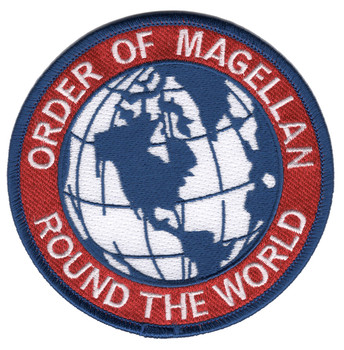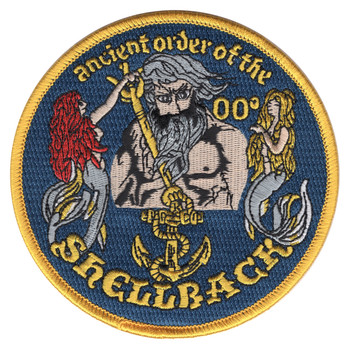Description
Order of the Spanish Main Patch 4.0" x 4.0" Embroidered Patch with Iron-On Backing
Superior Materials: Made with premium polyester thread and durable twill fabric, ensuring long-lasting color and strength.
Advanced Embroidery Technology: Crafted using the most advanced embroidery machinery, guaranteeing intricate detail, sharp lines, and consistent quality every time.
Easy Iron-On Application: Features a heat-activated adhesive backing for quick, no-sew attachment. Simply position, iron, and press for a secure bond.
Versatile Use: Perfect for personalizing jackets, backpacks, uniforms, or any fabric surface that needs a touch of personality.
Durable and Washable: Designed to withstand everyday wear and occasional washing without fading or fraying.
Formations & Origins
The Order of the Spanish Main patch is a symbol representing a unique aspect of U.S. Navy history, linked to the tradition of the naval forces’ efforts during the early years of the 20th century. The "Spanish Main" refers to the Caribbean coast of Latin America, particularly the Spanish-controlled territories during the Age of Exploration and the Spanish Empire’s peak. The name comes from the golden age of piracy and naval warfare that took place around the Caribbean, often involving pirates, merchant ships, and navies in the region. The "Order of the Spanish Main" patch was created as an unofficial award or recognition for sailors who participated in operations related to naval engagements in the Caribbean or Spanish territories.
Though the origins are more a naval tradition than a formal military unit, the patch became symbolic of an era marked by naval engagements, anti-piracy operations, and strategic importance in the Western Hemisphere. This patch serves as an honor for those sailors who served in the broader scope of naval operations, particularly in the Caribbean, throughout U.S. Navy history. Over time, it became associated with those who served during specific periods of heightened military activity in the Caribbean, especially following the Spanish-American War of 1898.
Notable Commanders
Although the Order of the Spanish Main patch is not tied to a single military unit or battle, its recognition ties back to the leadership of key naval commanders during significant engagements in the Caribbean. Admiral William T. Sampson served as the commander of the U.S. Navy during the Spanish-American War, playing a key role in the naval blockade of Cuba. His leadership in the battle of Santiago de Cuba in 1898 was pivotal in defeating the Spanish fleet and establishing U.S. naval dominance in the Caribbean. Admiral John J. Pershing, though most famous for his role in World War I, served in the Caribbean during the U.S. military's engagements with Spain and later on in military actions in the region. Admiral Chester W. Nimitz served in the U.S. Navy during World War II, further exemplifying the U.S. Navy’s increasing interest in the Caribbean’s strategic importance.
Major Campaigns/Operations
The Order of the Spanish Main patch is not associated with one single campaign, but it represents the many naval operations and skirmishes that took place in the Caribbean and surrounding waters. The Spanish-American War of 1898 was pivotal in establishing U.S. naval power in the Caribbean and the Pacific. The Battle of Santiago de Cuba, where the U.S. Navy decisively defeated the Spanish fleet, marked a major turning point in the war and the Spanish colonial empire's presence in the Caribbean. U.S. Navy sailors who participated in this battle and the wider naval campaign were often awarded or recognized with a variant of this patch for their service in the Spanish Main.
The Banana Wars, a series of military interventions and occupations in Central America and the Caribbean, often involved U.S. Navy forces. These engagements, particularly in Panama, Cuba, and Haiti, were part of a broader strategy to protect U.S. interests in the Western Hemisphere. The sailors involved in these operations, especially those involved in anti-piracy and anti-revolutionary efforts in the Caribbean, were among those who wore the "Order of the Spanish Main" patch. The Cuban Missile Crisis in 1962 marked another critical moment for U.S. naval power in the Caribbean. While not directly associated with the creation of the patch, sailors who served during this critical Cold War event and those involved in maritime blockades or Cuban reconnaissance operations were connected to the broader legacy of U.S. Navy dominance in the region, linking them to the tradition represented by the Order of the Spanish Main.
Specialized Role/Equipment
The Order of the Spanish Main patch, though not tied to a specific piece of equipment or unit, embodies the naval operations, many of which required specialized equipment and tactics. The patch recalls the naval power of the time, especially the cruisers and battleships like the USS Maine and the USS Olympia, which were iconic during the Spanish-American War. The U.S. Navy’s modern and heavily armed vessels were crucial to maintaining control over the Caribbean and enforcing naval blockades. During the 19th and early 20th centuries, piracy was still a concern in the Caribbean, and the U.S. Navy participated in several anti-piracy campaigns. These operations involved boarding hostile ships, taking down armed rebels, and securing strategic ports and cities from piracy.
The evolution of amphibious warfare, particularly the use of landing craft and amphibious transport ships, was integral to many operations in the Caribbean. This technology became increasingly important in the post-World War II era as the U.S. sought to maintain a military presence in the region.
Acts of Heroism
While the Order of the Spanish Main patch is not linked to a specific individual act of heroism, the legacy of this naval tradition carries with it numerous acts of bravery from the men and women who served in U.S. Navy operations in the Caribbean. Sailors and officers involved in the Battle of Santiago de Cuba during the Spanish-American War displayed immense courage as they faced superior Spanish fortifications and naval assets. The battle culminated in the destruction of the Spanish fleet, with U.S. forces bravely engaging despite the risks posed by the coastal defenses and the threat of Spanish reinforcements.
Many acts of bravery were performed by sailors and Marines during anti-piracy operations throughout the Caribbean. These operations involved boarding hostile ships, taking down armed rebels, and securing strategic ports and cities from piracy. U.S. Navy personnel took part in a tense naval blockade off the coast of Cuba during the Cuban Missile Crisis. Sailors and officers were tasked with enforcing a quarantine, risking escalation into open conflict with the Soviet Union. The courage and restraint shown during these operations are considered acts of heroism by many military historians.
Legacy & Notable Achievements
The Order of the Spanish Main patch symbolizes not just a naval tradition but also the evolution of U.S. naval power in the Caribbean and beyond. Its legacy is tied to the many missions and operations that the U.S. Navy has undertaken in the region, ranging from combat operations to humanitarian aid missions. The Spanish-American War and subsequent naval operations in the Caribbean established the U.S. Navy as a significant global power, capable of projecting force and influence in the Western Hemisphere and beyond. The defeat of Spain in 1898 marked a turning point in the history of U.S. foreign policy, leading to the expansion of its military presence in key strategic areas.
The legacy of U.S. naval counter-piracy efforts in the Caribbean and Gulf of Mexico contributed significantly to maritime security in the region, laying the groundwork for the Navy's continued role in global security and combating maritime threats such as drug trafficking and piracy. The U.S. Navy has maintained a significant presence in the Caribbean for more than a century, influencing key geopolitical decisions and supporting U.S. interests in the region. This presence continues today with ongoing operations related to counter-narcotics, security cooperation with allied nations, and humanitarian support.
The Order of the Spanish Main patch, though it may not be formally issued or widely recognized in modern times, remains an emblem of U.S. Navy history and the strategic importance of the Caribbean region. It celebrates the heroism, sacrifices, and contributions of those sailors and officers who answered the call to serve in one of the most dynamic and important areas of U.S. military operations.






